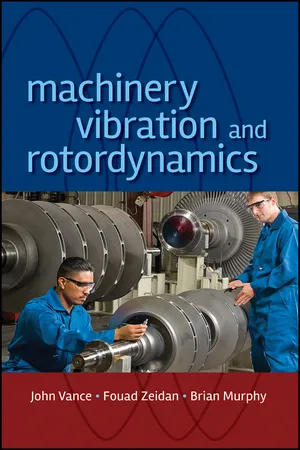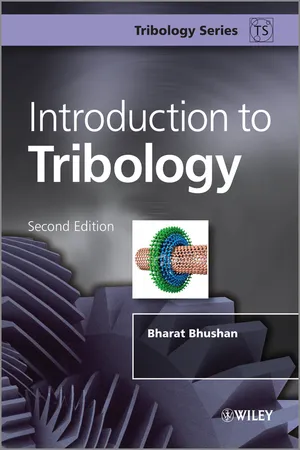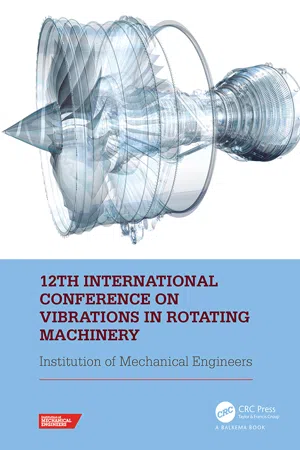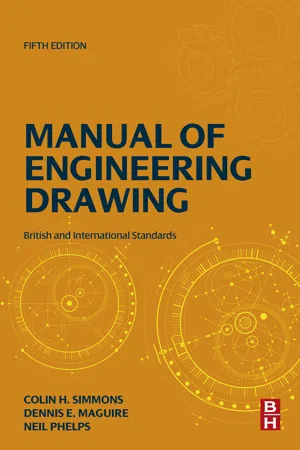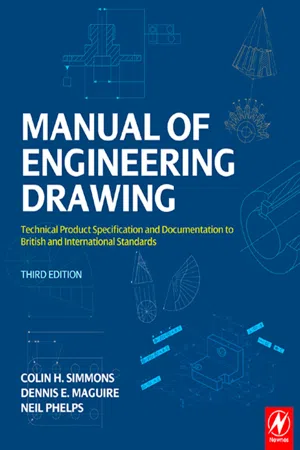Fluid Bearing
A fluid bearing is a type of bearing that uses a thin layer of fluid to separate the moving parts. This fluid layer reduces friction and wear, allowing for smooth and efficient operation. Fluid bearings are commonly used in various engineering applications, including in machinery, turbines, and high-speed rotating equipment.
7 Key excerpts on "Fluid Bearing"
- eBook - ePub
- John M. Vance, Fouad Y. Zeidan, Brian G. Murphy(Authors)
- 2010(Publication Date)
- Wiley(Publisher)
...Most fluid film bearings are of the hydrodynamic type, where the film pressure is produced by the shaft rotation dragging the oil into the converging wedge formed by the shaft and the bearing surface. In hydrodynamic bearings the oil pressure is just enough to keep the bearing supplied with oil and to remove the frictional heat generated by the viscous shear in the thin film. A less common type of fluid film bearing is the hydrostatic type, where the film pressure is provided through external pressurization and feeds a recess in the bearing that supports the load. Such a bearing requires pressurization that is orders of magnitude higher than that needed for a hydrodynamic bearing, and a significant power is required to drive the high-pressure oil pump. This purely hydrostatic bearing is sometimes applied based on the premise of providing a very stiff bearing through external pressurization of the bearing. This may be needed in some instances if the hydrodynamic generated film is not sufficient to build such stiffness due to unfavorable conditions such as low speed or inadequately sized bearings. Hydrostatic bearings are also used to provide a very stiff support and to allow rigid rotors to operate subcritical. This approach of providing very stiff bearings is successful only in limited applications. The discussion in Chapter 3 and further discussion on squeeze film damper supports show that a softer bearing approach is better for both stability and synchronous response. The hydrostatic bearing approach is sometimes utilized to complement or in combination with the hydrodynamic bearing. This is usually the case in large equipment and in conditions where the start-up torque is high. The hydrostatic features described above may be employed just for starting and when shutting the machine down...
- eBook - ePub
- Bharat Bhushan(Author)
- 2013(Publication Date)
- Wiley(Publisher)
...Hydrostatic bearings may also be required in applications where, for one reason or another, touching or rubbing of the bearing surfaces cannot be permitted at startup and shutdown. In addition, hydrostatic bearings provide high stiffness. Hydrostatic bearings, however, have the disadvantage of requiring high-pressure pumps and equipment for fluid cleaning, which adds to space and cost. In hydrostatic bearings, corrosive (chemical) wear of the bearing surfaces occurs as a result of interaction of the lubricant with the interface materials. 8.2.2 Hydrodynamic Lubrication Hydrodynamic (HD) lubrication is sometimes called fluid-film or thick-film lubrication. As a bearing with convergent shape in the direction of motion starts to move in the longitudinal direction from rest, a thin layer of fluid is pulled through because of viscous entrainment and is then compressed between the bearing surfaces, creating a sufficient (hydrodynamic) pressure to support the load without any external pumping agency, Figure 8.2.1. This is the principle of hydrodynamic lubrication, a mechanism that is essential to the efficient functioning of the hydrodynamic journal and thrust bearings widely used in modern industry. A high load capacity can be achieved in the bearings that operate at high velocities in the presence of fluids of high viscosity. These bearings are also called self-acting bearings (Pinkus and Sternlicht 1961; Cameron, 1976; Gross et al., 1980; Booser, 1984; Fuller, 1984; Frene et al., 1997; Bhushan, 2001; Khonsari and Booser, 2001; Hamrock et al., 2004; Szeri, 2010; Bruce, 2012). Fluid film can also be generated solely by a reciprocating or oscillating motion in the normal direction towards each other (squeeze) which may be fixed or variable in magnitude (transient or steady state). This load-carrying phenomenon arises from the fact that a viscous fluid cannot be instantaneously squeezed out from the interface with two surfaces that are approaching each other...
- eBook - ePub
12th International Conference on Vibrations in Rotating Machinery
Proceedings of the 12th Virtual Conference on Vibrations in Rotating Machinery (VIRM), 14-15 October 2020
- Institute of Mechanical Engineers, Institute of Mechanical Engineers(Authors)
- 2020(Publication Date)
- CRC Press(Publisher)
...Characteristics of a high speed thin film fluid lubricated bearing N.Y. Bailey Department of Mechanical Engineering, University of Bath, UK ABSTRACT A fluid lubricated bearing model is derived for operation under extreme operating conditions, including velocity slip boundary conditions appropriate for very small bearing face separation and retention of centrifugal inertia effects. Both compressible and incompressible Reynolds equations are formulated to model the fluid film and the fluid flow characteristics are examined for the steady state case. Coupling the fluid flow to the bearing structure, where the rotor and stator are modelled as spring-mass-damper systems, allows the dynamics to be examined when the bearing is subject to an external harmonic force. This replicates forces the bearing may be subject to when situated within a larger complex dynamical system. 1 Introduction Fluid lubricated bearing and seal technology comprises two structural components; namely a rotor and stator, which are separated by a thin fluid film that experiences relative rotational motion. The set up is of a thrust/axial bearing with radial flow and this type of technology is also described as non-contacting, gas-lubricated or film-riding and those containing an air film termed air-riding seal. Next generation bearing and seal technology aims to provide a considerable improvement in efficiency for applications characterised by higher rotational speeds and smaller operating clearances, possibly down to the order of several microns. To completely capture the dynamics of a fluid-lubricated bearing, the fluid flow and bearing structure need to be appropriately coupled together. If an external axial force is imposed on the bearing, a hydrodynamic force is typically generated by the normal motion of the faces, enhancing the local fluid film pressure, causing the fluid film to be maintained...
- eBook - ePub
Manual of Engineering Drawing
British and International Standards
- Colin H. Simmons, Dennis E. Maguire, Neil Phelps(Authors)
- 2020(Publication Date)
- Butterworth-Heinemann(Publisher)
...35 Bearings and applied technology Abstract In a plain bearing, the relative motion is by sliding in contrast with the rolling motion of ball and roller bearings. When surfaces rotate or slide, the rotational or sliding motion results in friction and heat. Energy is used, the surfaces wear, and this reduces component life and product efficiency. Friction may be reduced by lubrication which keeps the surfaces apart. At the same time, lubricants dissipate heat and maintain clean contact surfaces. Materials are carefully selected with appropriate mechanical and physical properties for bearings and their housings, to minimize the effects of friction, and particular care is taken with the accuracy of machining, surface finish and maintenance of all component parts associated with bearings. This chapter covers all types of bearings from Plain to Ball and Roller to Thrust and includes good advice on bearing selection, materials, alignment, lubrication, loads, rigidity, speeds, mounting and dismounting, seals, application, and finally fits and tolerances. Keywords Bearings; Ball; Roller; Needle; Seals When surfaces rotate or slide, the rotational or sliding motion results in friction and heat. Energy is used, the surfaces wear, and this reduces component life and product efficiency. Friction may be reduced by lubrication which keeps the surfaces apart. At the same time, lubricants dissipate heat and maintain clean contact surfaces...
- eBook - ePub
Manual of Engineering Drawing
Technical Product Specification and Documentation to British and International Standards
- Colin H. Simmons, Dennis E. Maguire(Authors)
- 2012(Publication Date)
- Butterworth-Heinemann(Publisher)
...Chapter 35 Bearings and Applied Technology When surfaces rotate or slide, the rotational or sliding motion results in friction and heat. Energy is used, the surfaces wear, and this reduces component life and product efficiency. Friction may be reduced by lubrication which keeps the surfaces apart. At the same time, lubricants dissipate heat and maintain clean contact surfaces. Materials are carefully selected with appropriate mechanical and physical properties for bearings and their housings, to minimize the effects of friction, and particular care is taken with the accuracy of machining, surface finish and maintenance of all component parts associated with bearings. In a plain bearing, the relative motion is by sliding in contrast with the rolling motion of ball and roller bearings. Plain Bearings Plain bearings may be classified as follows : The bearing metal should have a low coefficient of sliding friction, be able to conduct heat generated away from the bearing surfaces, resist wear in use and be tough enough to withstand shock loading in service. In the event of breakdown due to lack of lubrication, it may be desirable when overheating occurs for the bearing material to run, preventing seizure and possible severe damage to associated mechanical parts. Direct-lined Housings These housings are lined directly with bearing materials and the choice of material is limited by the practicality of keying or bonding the bearing material to the housing surface. The dimensions of the housings, casting temperatures and bonding characteristics of the bearing materials will determine whether metallurgical bonding is possible without unacceptable distortion of the housing. Generally this technique is limited to ferrous housings with low-melting point whitemetal bearing surfaces...
- eBook - ePub
Manual of Engineering Drawing
Technical Product Specification and Documentation to British and International Standards
- Colin H. Simmons, Dennis E. Maguire(Authors)
- 2009(Publication Date)
- Butterworth-Heinemann(Publisher)
...Chapter 32. Bearings and applied technology When surfaces rotate or slide, the rotational or sliding motion results in friction and heat. Energy is used, the surfaces wear, and this reduces component life and product efficiency. Friction may be reduced by lubrication which keeps the surfaces apart. At the same time, lubricants dissipate heat and maintain clean contact surfaces. Materials are carefully selected with appropriate mechanical and physical properties for bearings and their housings, to minimize the effects of friction, and particular care is taken with the accuracy of machining, surface finish and maintenance of all component parts associated with bearings. In a plain bearing, the relative motion is by sliding in contrast with the rolling motion of ball and roller bearings. Plain bearings Plain bearings may be classified as follows : The bearing metal should have a low coefficient of sliding friction, be able to conduct heat generated away from the bearing surfaces, resist wear in use and be tough enough to withstand shock loading in service. In the event of breakdown due to lack of lubrication, it may be desirable when overheating occurs for the bearing material to run, preventing seizure and possible severe damage to associated mechanical parts. Direct-lined housings These housings are lined directly with bearing materials and the choice of material is limited by the practicality of keying or bonding the bearing material to the housing surface. The dimensions of the housings, casting temperatures and bonding characteristics of the bearing materials will determine whether metallurgical bonding is possible without unacceptable distortion of the housing. Generally this technique is limited to ferrous housings with low-melting point whitemetal bearing surfaces...
- eBook - ePub
Interfacial Mechanics
Theories and Methods for Contact and Lubrication
- Jane Wang, Dong Zhu(Authors)
- 2019(Publication Date)
- CRC Press(Publisher)
...Pressurized fluid may be supplied to the interface that is able to support the load and separate the surfaces for the purpose of reducing friction and wear. This mechanism can be found in some journal and thrust bearings and seals, and it is usually called “hydrostatic lubrication”. On the other hand, without externally applied pressure, the surface separation may still be accomplished due to internally generated hydrodynamic pressure primarily under the following conditions (see Figure 5.1): There is a sufficient amount of viscous fluid supplied to the interface as lubricant; The fluid lubricant gets into a small convergent gap formed by the two surfaces; There is an entraining and/or a squeezing motion between the two surfaces relative to the contact zone. FIGURE 5.1 Formation of hydrodynamic lubrication. This type of lubrication with the surface separation resulted from internally generated hydrodynamic pressure is commonly called the “hydrodynamic lubrication”. In fact, both hydrostatic and hydrodynamic lubrication mechanisms are laid on the same physical ground, and they can be analyzed with the same (or similar) mathematic model. Moreover, they often coexist in some engineering applications. Actually, in a general sense, hydrostatic lubrication can be considered as a special case of the hydrodynamic lubrication under certain conditions, so it will not be separately discussed in this book. A deep understanding of hydrodynamic lubrication is extremely important not only for components design; product development; and improvements of performance, efficiency, and durability, but also for laying a solid foundation for studying other more complex interfacial phenomena. Basically there are two fundamental physical elements for describing or modeling a general interfacial system...
